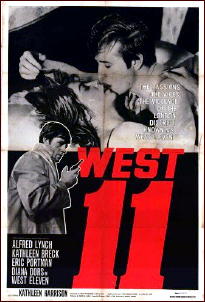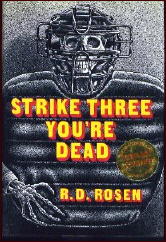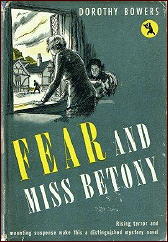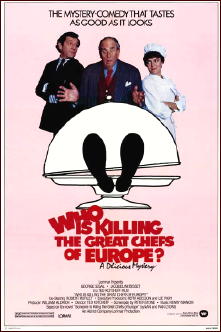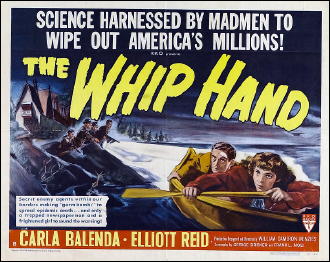September 2011
Monthly Archive
Fri 30 Sep 2011
WEST 11. Warner-Pathé, UK, 1963. Alfred Lynch, Kathleen Breck, Eric Portman, Diana Dors, Kathleen Harrison, Finlay Currie. Director: Michael Winner.
A minor, all-but-forgotten film, one that Leonard Maltin’s book (2009 edition) gives only one and a half stars to, but it’s far better than that. Filmed on location in London’s Notting Hill section, West 11 (named after the postal code) is a true noir film. If you’re ever able to see this film, you’re likely not to forget it for a while.
That it’s filmed in black-and-white only adds to the mood: rundown post-war apartment complexes, seedy eating establishments and swinging basement level jazz clubs, rain-slicked streets, and members of both sexes searching for love and the meaning of life (with sex on sweat-stained sheets standing in as a poor substitute for companionship).
The movie is slow in getting going, I admit that (which I’m sure explains Maltin’s use of the word “lumbering†to describe it). One might easily get frustrated in following Joe Beckett (Alfred Lynch) around – Beckett is an emotional cripple stumbling from job to job, from girl to girl (Kathleen Breck, and the slightly older Diana Dors), unable even to love his mother (Kathleen Harrison) – if one were not fully aware of the interest that the old soldier-type Richard Dyce (Eric Portman) has in him.
The criminous portion of this film is confined to the final 20 minutes – Dyce has an aunt who he believes has lived long enough, and Beckett might be just the person to do something about it – but the slow build-up is worth the wait. And it should be noted that by the time the 60s had rolled around, noirish films like this one were no longer required to have “happy†endings, as most of them in the 40s and 50s needed to do.
Note: Here’s an amusing two minute clip from YouTube. I think what’s happening is self-explanatory.
Fri 30 Sep 2011
Posted by Steve under
Reviews[5] Comments
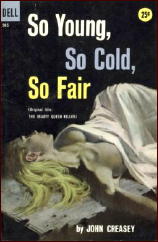
JOHN CREASEY – So Young, So Cold, So Fair. Dell #985, paperback, August 1958. Hardcover editions: Harper & Brothers, US, 1956, as Beauty Queen Killer; UK, Hodder & Stoughton, 1954, as A Beauty for Inspector West. Reprinted several other times in paperback, including Berkley F1095 (1965), and Pan-UK (1956).
I think I like the British title best, but the one they came up with for the Dell paperback, which is the one I just read, has a certain poetic ring to it. (It comes from the ballad “St. James Infirmary,†if it sounded familiar to you and couldn’t quite place it.)
I don’t usually read novels with serial killers in them, but this one sort of sneaked up on me, and I’d long since committed myself to it before I realized it.
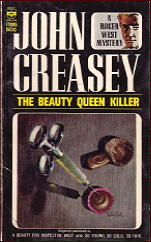
Being killed, in methodical but not identical fashion – the killer being content to use any method that works – are the local district winners of a beauty contest being sponsored by a London soap company. And when the papers find out about it, their banner headlines make Inspector Roger “Handsome†West wish that maybe he was in another line of work.
There are a lot of clues to be followed up on, some of them straightforward, some of them contradictory, and it takes all of West’s efforts throughout the book to determine which is which. But this is no mere novel of detection. There are several action scenes every so often designed to pump up the reader’s interest, and very effectively, too.
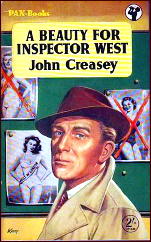
Complicating matters somewhat is that West has been assigned an assistant copper he doesn’t particularly like, but since it happens that DI Turnbull saves West’s life early on in the tale, he’s forced to keep him on the case. A roving eye for the ladies is one of Turnbull’s flaws, and in this case, it’s one of the beauty queens who attracts his immediate attention, which makes her present two suitors, both suspects, as it turns out, rather annoyed. (It is hard to say which one over the other.)
So this is the story that Creasey does a fine job with, although in somehwat of a heavy-handed fashion. As a detective story, it is rather a straightforward one. It is difficult to say how he manages to keep his cards so well hidden that the killer comes as a surprise, and yet an obvious one, but he does.
Or at least I think so. Now that the book is finished, I might want to go back and see if it all holds together. But I won’t, simply because maybe it won’t. Hold together, that is. I’m going to leave well enough alone.
Fri 30 Sep 2011
Posted by Steve under
Reviews[4] Comments
GEORGE BAGBY – Murder Calling “50â€. Doubleday/Crime Club, hardcover, 1942.
History books are fine, but they don’t tell the whole story. The same pieces of personal history may occur for millions of people everyday, small events that affect their lives many times over, but they hardly ever make it into the history books, and if they do, you’ll only find them in the footnotes. By the time the children of a generation or two later come along, pieces of their parents’ lives are gone, totally forgotten.
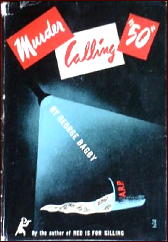
Personal diaries and mystery stories, that’s the only way some important things will ever be remembered. A case in point: this book (of course), which centers about the air raid drills and blackouts that took place in New York City (and probably all up and down the East Coast; California was looking in another direction).
If you didn’t live through the days themselves, who remembers anything about them today? Even the title of this book has no significance any more. Air raid wardens and civil defense personnel had to spread the word when a drill (or actual attack) was coming, and they did it by phone and by code; everyone who was called was required to spread the word to three or four others. “50†is the code for “man your posts.†“52†is the code for “all clear.â€
Who knows this today? Who remembers the routine of blackout curtains, heading for designated apartments in a building until the all-clear was sounded, or even buckets of sand placed on every floor?
Or who would know, from a chapter in a history book, how uncertain and confusing the times were in those days? Even with CNN on the job today, rumors and speculation ran rampant during the Persian Gulf War. What must it have been like without?
And of course, all this makes an ideal background for a murder mystery, one that takes place in Bagby’s building while his friend Inspector Schmidt (he of the always aching feet) is visiting. There is a dead man, of course; his wealthy patron; a young couple in love but not quite sure of each other; a Russian princess (and faithful milkman); a playgirl and a Broadway sharpster.
All of the above are characters in Murder Calling “50â€, along with flights and flights of stairs in the dark, dog leashes, strange noises, family jewels, elevator boys and the above-mentioned buckets of sand (handy for showing footprints in bathrooms, if nothing else).
You probably know from this if this is the type of book for you, but if you like George Bagby/Aaron Marc Stein’s work (as I do), I should also tell you that I didn’t find it one of his better ones.
For technical reasons, that is. The question not answered concerning the bombshell Schmitty reveals on p.257 is “When did he know, and how did he find out?†I suspect it was the mysterious one-sided phone conversation he had on p.213, but I don’t think we’ll ever know for sure.
There were a couple of other questions left unanswered at story’s end. I won’t go into any of these — they’re relatively minor, and they have no particular effect on events, and then only before the murder, not afterward. But it would have taken Bagby only a couple of extra pages, perhaps, to fill us in, and I realize that I’m a little late in saying that I wish he had.
Rating: C Plus.
— This review was intended to appear in
Mystery*File 35. It was first published in
Deadly Pleasures, Vol. 1, No. 3, Fall 1993 (slightly revised).
Fri 30 Sep 2011
REVIEWED BY WALTER ALBERT:
THE DUCHESS OF BUFFALO. First National Pictures, 1926. Constance Talmadge, Tullio Carminati, Edward Martindale, Rose Dione, Chester Conklin. Screenplay by Hans Kraly based on the play Sybil by Max Bordy and Franz Martos. Director: Sidney Franklin. Shown at Cinevent 40, Columbus OH, May 2008.
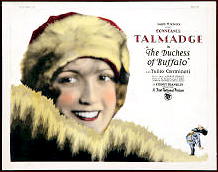
The beautiful Constance Talmadge plays Marian Duncan, an American dancer who’s touring Russia and leaving broken hearts in her wake. She’s fallen in love with a young lieutenant (Tullio Carminati) but she’s caught the attention of an aging roué (Edward Martindale), a Grand Duke who’s also the commanding officer of the hapless lieutenant.
This is a tightly constructed romantic comedy, highlighted by a lengthy climax in which the lieutenant, Marion, the Grand Duke, and the Grand Duchess play an elaborate game of musical chairs in a hotel suite, a classic drawing room comedy situation that brings this witty play to a resolution that pleases everyone except, perhaps, the Grand Duke.
Thu 29 Sep 2011
IT’S ABOUT CRIME, by Marvin Lachman
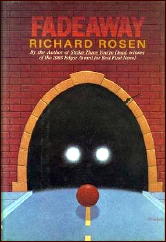
RICHARD ROSEN —
â— Fadeaway. Harper, hardcover, September 1986. Onyx, paperback, September 1987.
â— Saturday Night Dead. Viking, hardcover, June 1988. Onyx, paperback, June 1989.
Though I don’t really understand why Harvey Blissberg abandoned baseball at age thirty to become a private eye, and Richard Rosen doesn’t satisfactorily explain it, I am nonetheless glad to welcome him to the shamus corps.
Rosen’s second book, Fadeaway, does for basketball what his first, Strike Three, You’re Dead, did for baseball. Rosen writes better sports mysteries than anyone I know, except, of course, Dick Francis. I also like the way Rosen uses Providence, R.I., not your everyday mystery locale. Sure his solution is telegraphed, but Western Union has to live also.
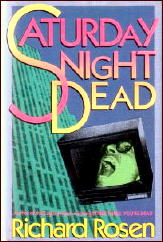
In Saturday Night Dead, Rosen and Blissberg almost desert sports, though Harvey gets his case through an old baseball buddy. His work is more as a bodyguard than a detective, but what would one expect of a detective from the same town as Spenser.
Rosen worked for many years in television, and he does a great job with a comedy show that, as the title indicates, is remarkably like Saturday Night Live. He even includes some brand-new sketches, including one, “Death of a Mailman,” which is a hilarious send-up of Arthur Miller.
Despite an overly melodramatic ending, this book does nothing to detract from Rosen’s status as one of the best new writers of the 1980s.
— Reprinted from The MYSTERY FANcier,
Vol. 12, No. 4, Fall 1990.
The Harvey Blissberg series —
1. Strike Three You’re Dead (1984) [Edgar Award winner for Best First Novel.]
2. Fadeaway (1986)
3. Saturday Night Dead (1988)
4. World Of Hurt (1994)
5. Dead Ball (2001)
Thu 29 Sep 2011
Posted by Steve under
Baseball[13] Comments
I watched more baseball on TV last night than I have all year. It was the last day of the regular season, and I can’t remember when there were more unknowns for the playoffs on the day of Game 162 — who was playing whom and where — than yesterday.
There were actually three games I was switching back and forth between. Mostly I was watching Boston play Baltimore, but at the end of each half inning, I went down two channels to see how Tampa Bay was faring against the Yankees. Whenever both games were playing commercials — more often than you’d think — I flipped over to one of the ESPN channels to watch Atlanta play the Phillies.
Two of the games went into extra innings, and one was decided in the ninth in a stunning comeback against the second best reliever in baseball. All three were epics that fans will remember for a long time, with dramatic home runs and fielding plays galore, but what I kept thinking of is how much the other 161 games matter too.
Two of the teams, Boston and Atlanta failed badly down the stretch, and I mean badly, relinquishing leads in the standings next to impossible to lose, or so you’d think. If this had been fiction, no one would have believed it. It’s why when the sports pulps died, they stayed dead.
My team, Detroit, is still in the running. They play the Yankees on Friday night. If I had to cheer on a National League team, it would be Arizona, managed and coached by two of my favorite former players, Kirk Gibson and Alan Trammell.
Both played for Detroit, of course.
Wed 28 Sep 2011
THE BACKWARD REVIEWER
William F. Deeck
DOROTHY BOWERS – The Bells of Old Bailey. Doubleday Crime Club, US, hardcover, 1947. Originally published in the UK: Hodder & Stoughton, hardcover, 1947, as The Bells at Old Bailey.
While it would at first appear that my bias against detective-story characters who do not report information to the police ought to be shaken by the main event in this novel, later incidents validate my opinion.
Miss Tidy, the proprietress of Minerva Hatshop, Beauty Parlor and Teashop, receives two poison-pen letters following a series of unlikely suicides in Ravenchurch, where her establishments are located, and Long Greeting, where she lives.
Taking the letters to the police, Miss Tidy argues that the suicides were well-executed murders. Dubiety on the suicides greets her efforts, and there’s no small suspicion that Miss Tidy wrote the letters herself. But then —
To go on would reveal information that some readers would rather not know as they begin the novel. Suffice it to say that Bowers has written a charming novel about an English village, with all that that implies — to wit, blackmail and murder — and including an antiquarian bookseller, a detective-story writer, and a mainstream novelist for the biblio enthusiasts.
Also there is fair play for the most part. Bowers is another author I am adding to my long list of writers whose books are sought after.
— From The MYSTERY FANcier, Vol. 12, No. 4, Fall 1990.
Bibliographic Notes: Dorothy Bowers wrote four crime novels before The Bells of Old Bailey, all featuring Chief Inspector Dan Pardoe. All were first published in the US by Doubleday Crime Club. They are difficult to find as first editions; if anyone might be looking for copies to read, all four have been reprinted by Rue Morgue Press.
Postscript to Poison. Hodder 1938.
Shadows Before. Hodder 1939.
Deed Without a Name. Hodder 1940
Fear for Miss Betony. Hodder 1941. US title: Fear and Miss Betony.
Wed 28 Sep 2011
Posted by Steve under
ReviewsNo Comments
IT IS PURELY MY OPINION
Reviews by L. J. Roberts
DEBORAH CROMBIE – A Finer End. Bantam, hardcover, May 2001; paperback, May 2002.
Genre: Police procedural. Leading characters: DI’s Duncan Kincaid & Gemma James; 7th in series. Setting: England.
First Sentence: The shadows crept into Jack Montfort’s small office, filling the corners with a comfortable dimness.
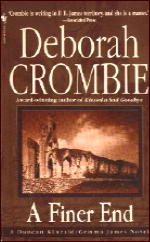
DI’s Duncan Kincaid and Gemma Jones travel to Glastonbury, Scotland after a call from Duncan’s architect cousin, Jack Montfort. It appears that Jack may be a conduit via automatic writing for a medieval monk who wants Jack to find a missing relic.
Duncan is not the only one who knows about Jack’s unasked for link to the past. Anglican priest and Jack’s lover, Winnie; Nick, a handsome, young bookstore clerk; Faith, the very pregnant, psychically-sensitive runaway; Garnet, the reclusive, new-age potter, and Simon, a Church-scholar with his own secrets, all join with Jack to uncover what is happening. An attempted murder and an actual murder blend the paranormal with police procedure.
Crombie certainly knows how to capture your attention and draw you straight into the story. From the very first page, Crombie creates a delicious sense of menace and foreboding; a sense of something supernatural at work. This is wonderfully offset of the everyday, very real concerns in Gemma’s and Duncan’s lives and their ever-evolving relationship.
We are well introduced to the cast of characters, learning who they are and how they interconnect. They were rather fascinating and unusual for a mystery. Certainly, they all had pasts and elements of those pasts they wanted to keep from being revealed. However, it was refreshing that there wasn’t an obvious villain in the group. That made the final resolution even more effective when it was revealed.
The history was fascinating and well imparted, from the furnishing in one character’s home to information on the Abbey. Crombie’s descriptions are wonderful. She is an author who paints with words and, in this case, sent me straight to the internet looking for more information.
I particularly loved the role music played in the story including Gemma’s reaction to music and the conveyance of when music touches your soul, as well as learning that the word “enchantment’ is derived from the work chant as it was believe music was the strongest magic.
On the other side, I did feel there were some dubious bits of information concerned religion, old and new, and pottery. There were also a couple significant coincidences and a few threads left hanging. I enjoyed the paranormal element but might have found it more interesting to have a non-paranormal resolution.
In summary, we have a story a bit heavy on the paranormal but a captivating plot, lots of viable suspects and excellent plot twists. All in all, it worked for me.
Rating: Good Plus.
Previously on this blog:
A Share in Death. (Reviewed by Steve Lewis.)
Mon 26 Sep 2011
REVIEWED BY MICHAEL SHONK:
WHO IS KILLING THE GREAT CHEFS OF EUROPE? Lorimar (now Warner Brothers), 1978. Cast: Jacqueline Bisset as Natasha O’Brien, George Segal as Robby Ross, Robert Morley as Maximillian Vandeveer. Screenplay by Peter Stone, based on the novel Someone Is Killing the Great Chefs of Europe by Ivan and Nan Lyons. Director: Ted Kotcheff.
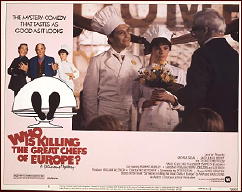
In Who Is Killing the Great Chefs of Europe? the world’s finest dessert chef Natasha O’Brien finds herself between a killer out to rid Europe of its greatest chefs and her ex-husband who wants her back.
Award-winning writer Peter Stone took the funny mystery by Ivan and Nat Lyons and gave it the style of Stone’s earlier romance suspense films such as Charade. Shot on location with some of Europe’s best actors, Who Is Killing the Great Chefs of Europe? remains an excellent example of the sophisticated adult romantic comedies that today exists only in our memories and DVDs.
The film begins with Maximillian Vandeveer, played to perfection by Robert Morley. Max is a food critic, publisher of a famous gourmet magazine and addicted to the best foods, and he is dying for those sins. Max is told he will die soon if he does not lose weight, but he responds he doesn’t want to live without his favorite meals.
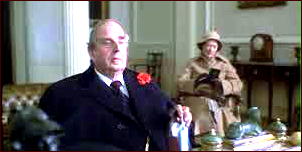
Max has arranged for two famous chefs to cook a dinner for the Queen. One of the chefs is Swiss Louie Kohler, the greatest chef in England, and the other is Natasha. Arriving in London, Natasha is kidnapped. She has no idea who or why anyone would kidnap her, but she is more annoyed by the delay than scared by the danger. The beautiful Jacqueline Bisset is delightful as Natasha, a confident pampered woman still hurting from her ex-husband’s affair and, more importantly, him letting the other woman use her kitchen.
Natasha’s ex and millionaire fast food king Robby Ross, played a little over the top by George Segal, has kidnapped Natasha to ask her to be the Master Chef for his new fast food omelette chain called H. Dumpty. She turns him down.
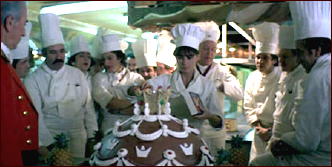
Kohler and Natasha prepare the meal for the Queen. The meal is a great success as is Louie’s attempt to seduce Natasha. In the morning she finds him dead, baked in an oven in the style of his famous baked pigeon dish. The police suspect Natasha until Robby blunders into the role of chief suspect.
Max sends Natasha to Venice to interview the greatest chef in Italy. There he explains, hands on, why Italian men pinch women, appropriately enough his specialty is lobster. Robby unexpectedly arrives. He is still searching for a famous chef to front H. Dumpty. Again, it is Natasha’s fate to find the murdered chef’s body, drowned in his lobster tank.
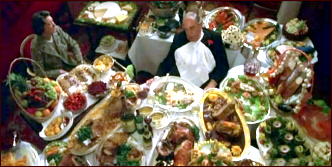
Robby realizes if the great chefs of England and Italy have been murdered, the greatest chef in France may be next. He contacts six of the greatest chefs in France, sets up a meeting, and invites Natasha to come with him. In a scene of blocking genius, when Robby and Natasha arrive the chefs are all sitting so each could not see any of the others. Each chef is convinced that only he could be the greatest chef of France. They all agree that a French chef should have been killed first.
As the tension and mystery intensifies, so does the romance between Robby and Natasha, much to the displeasure of Max.
With the death of the French chef, Natasha realizes how the victims were selected and that she is next on the menu. But when Max tells Natasha that the killer has confessed, all relax. Max sends Natasha to do a cooking show called “The Movable Feast”. On the show Natasha will show how to cook the dessert she made for the Queen, a bombe.
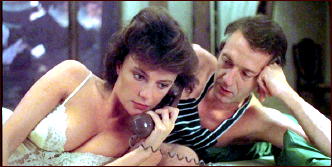
While the mystery would not challenge Ellery Queen, there are clues, suspects, and a killer that satisfies the detective in us. It is not only who the killer is, but who the next victim will be that maintains the story suspense.
What makes this film so special is its wonderful intelligent adult humor. Metaphors using food abound. The conflict between Robby and Max over Natasha, each loving and needing her in different ways, give a new twist to the romantic triangle. As any good comedy mystery, after the real killer confesses, there is a nice epilogue giving the characters closure. The final scene of Who Is Killing the Great Chefs of Europe? will leave you smiling and humming the delightful Henry Mancini’s theme music as the credits roll.
Mon 26 Sep 2011
REVIEWED BY DAN STUMPF:
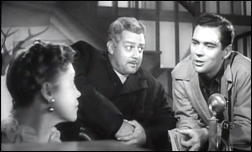
THE WHIP HAND. RKO Radio Pictures, 1951. Carla Balenda, Elliott Reid, Edgar Barrier, Raymond Burr, Otto Waldis, Michael Steele, Lurene Tuttle, Peter Brocco. Director: William Cameron Menzies.
Amid the general anonymity of reds-under-the beds cold-war movies, The Whip Hand comes as a pleasant surprise: a quirky, paranoid little film from a master of the form, William Cameron Menzies, whose Invaders from Mars (1953) set the standard for quirky paranoia.
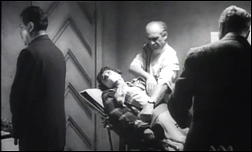
Actually Whip wasn’t supposed to be about the Red Menace; it started its weird little life as a movie about finding Hitler holed up in mid-west USA. But when Howard Hughes, then the head of RKO saw it, he said Hitler was last year’s boogie man and they should change the story to something about a Commie plot. Hence this pleasant trifle about sinister Russians infiltrating a small town to do experiments in mass murder.
Given this bifurcated birth, one would expect The Whip Hand to turn out as some godawful mess along the lines of They Saved Hitler’s Brain, but actually it’s a pretty neat job, thanks mainly to the visual intensity imparted to it by Director Menzies, a stylist also responsible for the look of films like Things to Come, Thief of Bagdad and The Black Book.
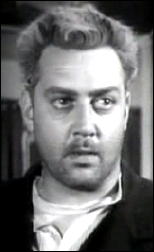
Menzies at his best has a way of exaggerating the look of ordinary things to evoke a slightly off-kilter feel, a sense that familiar things are somehow alien.
Thus the typical small town into which vacationing reporter Elliott Reid stumbles seems filled from the outset with subtle menace, and the people he encounters always seem to be hiding something just off-screen.
It all culminates in a nifty chase, a mad doctor’s lab, and a rattle of G-Man machine guns, but before we get there we’re treated to Raymond Burr at his nasty best.
Playing a second-string bad guy, Burr offers a patently fake folksy air and a booming hearty laugh at the feeblest of jokes that’s somehow more chilling than anything his boss-heavies put out here. It’s just one more reason to enjoy a movie that should be better known.
Next Page »
